
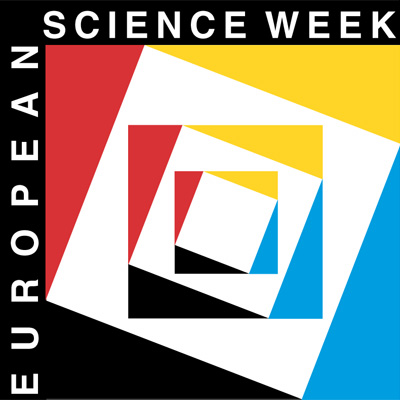
The Venus Transit 2004
... Extended InfoSheet F7
The 1882 Transit of Venus as Seen from Chile [1]
On April 28, 1883, a few months after the latest Venus transit, the illustrated newspaper Harpers Review published a picture showing a few youngsters watching the sun through a piece of blackened glass (Janiczek 1983). Its caption was taken from an article in Nature: "What will be the state of science when the next transit season arrives, God only knows. Not even our childrens' children will live to take part in the astronomy of that day..." (Harkness 1882)
We, the great-grandchildren of these youngsters, have the privilege to use the fancy telescopes to take part in the astronomy of today. And we also have the privilege to see the next transit of Venus: this year, on June 8, Venus will pass in front of the solar disk. The complete transit, which will take 7 1/3 hours, can be seen from Europe. Only 8 years later, on June 5, 2012, another Venus transit will be visible from Chile. We take the opportunity of the 2004 transit to recall the previous one of December 6, 1882, which was completely visible in the western hemisphere.
Why are Venus transits interesting?
One of the goals of astronomers of the 18th and 19th centuries was to determine the distance from the earth to the sun (the astronomical unit), or, alternatively, the solar parallax, being the angular diameter of the earth's semi-major equatorial axis as seen from the sun's center. The astronomical unit is the baseline for stellar parallax determinations, and is thus the first step of the cosmic distance scale. Following a suggestion of the famous astronomer Edmund Halley to determine this unit, the transit of Venus had to be observed from widely distant locations on earth (Halley 1716). He proposed to measure the time of duration of the transit; others suggested to determine ingress or egress times, or precise measurements of the location of Venus on the solar disk, in order to calculate the value of the solar parallax.
Halley's suggestion fell on fertile ground. Accounts of expeditions, mainly carried out by astronomers from France and England, to observe the Venus transits of 1761 and 1769 in the southern seas, Siberia or North America make fascinating reading (e.g. Woolf 1959, Fernie 2002), and have even entered modern literature (Mason & Dixon by Thomas Pynchon, Venuspassage by Lorenz Schröter). The huge amount of data collected during the 18th century transits was analyzed by Encke (1824) and Newcomb (1890).
References to expeditions to observe the 19th century transits are less frequently found in present-day literature, since the results did actually not lead to a major improvement of the value of the astronomical unit. Reasons of this failure are manifold: the methods employed were either too new to be reliable (photography), or too old-fashioned to improve on the earlier data (like timings of contact moments). At the time of the 19th century transits, planet or asteroid observations, either simultaneous from various points from earth, or evening-morning measurements from one observing station, also became accurate enough to obtain reliable parallaxes and distances from earth. The knowledge of the earth's distance of any - major or minor - planet, as well as its time of revolution around the sun, yields by means of the application of Kepler's third law, the distance between the earth and the sun. A favorable opposition of the earth-approaching asteroid Eros in 1900 gave a fresh impetus to the determination of the astronomical unit.
The 19th century Venus transits were not only monitored by expeditions from the established astronomical "superpowers" France and England, but by a bunch of "newcomers", like Austria, Belgium, Brazil, Denmark, Germany, Italy, Mexico, the Netherlands, Portugal, Russia, and the United States. And when it came to observe the 1882 transit from a good site in the southern hemisphere, Chile turned out to be an excellent choice. Word on this was also spread during an international conference on Venus transits held in Paris in early October, 1881. Among its participants was also the ancient director of the Chilean National Observatory, Carlos Moesta. There was a proposal to establish, after the return of the expeditions, an international commission of Venus passages, that should collect all observational data and to produce a general result for the solar parallax, but this early plan for an international cooperation came to nothing. It was only agreed to exchange the observations among the participating parties (anonymous, 1882). But even this resolution left no mark on subsequent research on the solar parallax: methods were too disparate, and publication progressed too slowly.
The Transit of Venus of 1882 as Observed from Chile
Astronomers from Belgium, Brazil, France, Germany and the United States spent a few weeks in or near Santiago and in Punta Arenas to observe the transit. We will briefly review the various groups and places, and tell about their achievements (Fig. 1). Luis Ladislão Zegers, a physicist at the Universidad de Chile, wrote a "noticia historica" on the observations carried out in Santiago and its vicinities. He cites a lot of correspondence and newspaper clippings, and actively took part as an assistant of the French transit expedition. Zegers is best known today because of his use of Roentgen's newly discovered X-rays for medical purposes only a few months after their first application in 1895 (Zegers and Salazar 1896).
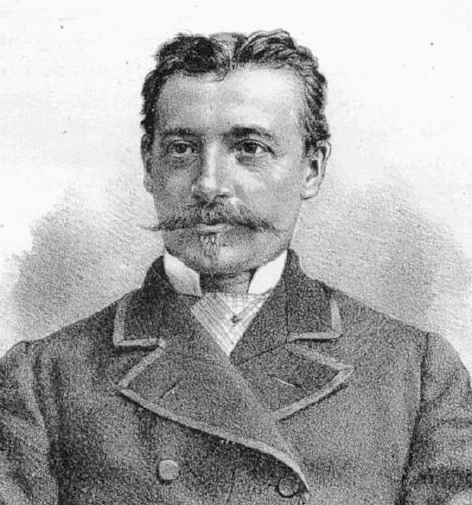
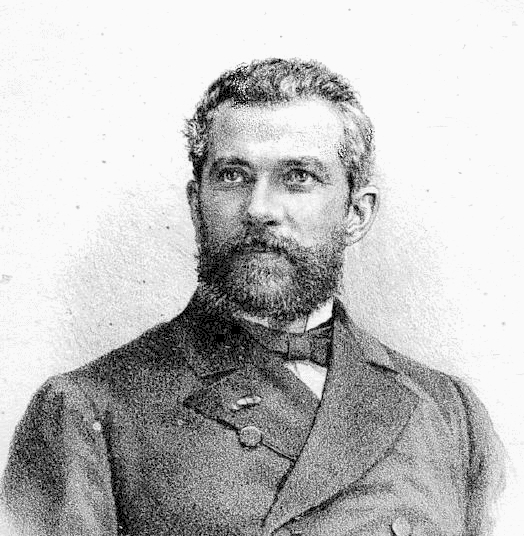
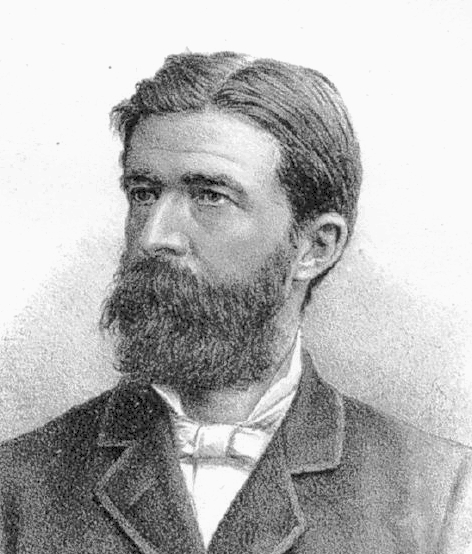
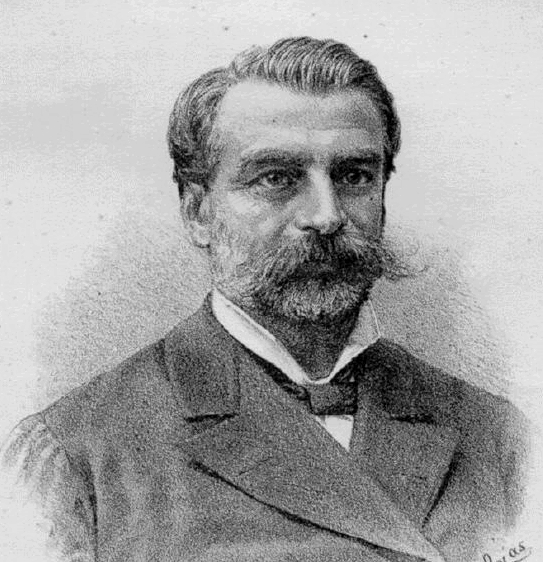
Figure 1: Portraits of the leaders of the Belgian, French and U. S. expeditions (from left to right: Louis Niesten, Octave de Bernardières, Lewis Boss) and of the director of the Chilean National Observatory, José Vergara (from Zegers 1883).
Let us briefly mention that Zegers' book does not inform us about the activity of the Observatorio Nacional on 1882 December 6, since this was due to the "authorized word of its director", José Vergara. Instead, Zegers quotes from Vergara's newspaper articles of the forthcoming event, gives a long history of the National Observatory, deplores its present state of decline, and then very briefly lists contact timings derived at the observatory ("debemos estos datos a la benevolencia del senor Director del Observatorio Nacional"). And this remained, according to my knowledge, the only printed result of the Venus transit observed by the Chilean National Observatory staff.
The expeditions of the Belgian, Brazilian, French and German expeditions are described in bulky books, issued by the observatories and commissions in charge of the projects, while the US activities are less well documented. In addition to the published sources, a lot of official documents survive: the German ones in the Archiv der Berlin-Brandenburgischen Akademie der Wissenschaften, the French ones in the Archive de l'Académie des Sciences, the U. S. ones in the National Archives and the U. S. Naval Observatory, Washington, DC.
The Belgian Group
Two Belgian expeditions observed the Venus transit of 1882, the first went to Chile, the second to San Antonio, Texas, to observe the transit from both southern and northern sites, in order to find the parallactic displacement of Venus on the solar disk. Both parties were equipped with identical instruments, so-called "heliometers with unequal objectives". This special arrangement, invented by Jean-Charles Houzeau, director of the Brussels Royal Observatory, consists of two semi-circle-shaped lenses of different diameters and focal lengths, which could be moved relative to each other by a micrometer. They produced a large and a small image of the sun, plus a large and a small image of Venus. The trick was to shift the two lenses of such a heliometer so that the small image of the sun, produced by the short-focus lens, coincided with the dark large image of Venus projected on the very large image of the sun, and to read the heliometer setting.
The "Chilean" party consisted of Louis Niesten, astronomer at the Royal Observatory of Brussels, Charles Lagrange, adjunct astronomer at the same institution, and Louis' brother Joseph Niesten, an artillery captain on leave from the War Ministry. A 45-day trip on the steamer Denderah brought them from Antwerp to Valparaiso. "After a railway trip of five hours", they arrived in Santiago on 1882 September 2, and set up their observing station in the garden of the Chilean National Observatory, which at that time was situated at the Quinta Normal in downtown Santiago. December 6, the day of the transit, was perfectly clear: "Since dawn, a clear sky - only a few clouds above the snowy peaks of the Andes - promised a wonderful day."
Indeed, 606 measurements of the position of Venus were taken with Houzeau's heliometer, and additional observations were made with refractors (Fig. 2). After finishing the observations, the party went by railway to Santa-Rosa, crossed the Cordillera on muleback, and returned by train and ship via Buenos-Aires to Belgium, happily finishing "the first scientific expedition organized by Belgium" (Niesten 1883). Jean-Charles Houzeau himself headed the "Texas" party, which suffered from clouds. Only about half of the transit could be observed, and 124 measures were taken. Two years after the transit, Houzeau (1884) published the report of the campaign, and his final result was: 8.911±0.084. He blamed the large error on the poor sky conditions in San Antonio and remarked that at least that this had been, after all the inconclusive observations of the 1874 event, a fresh method to observe a Venus transit.
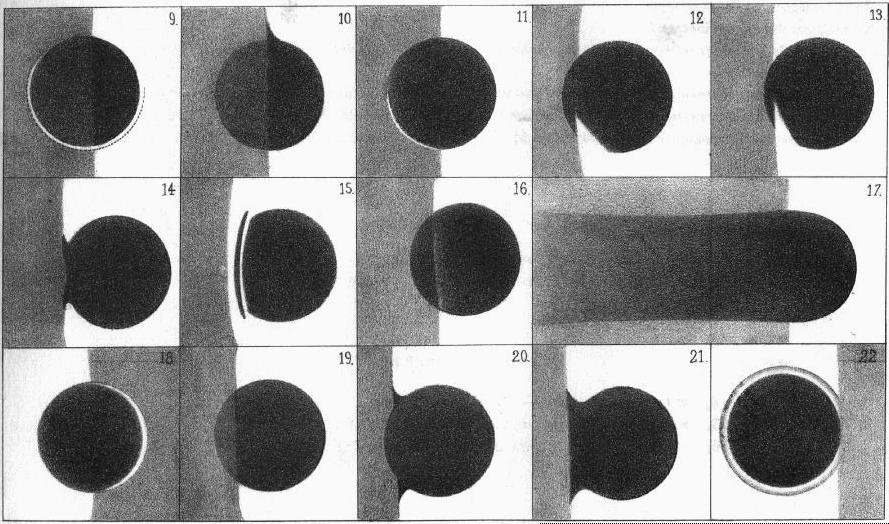
Figure 2: Disturbing effects at second contact, among them the famous "black drop effect", as observed by the Belgian observers (from Houzeau 1884).
The French Group
The French Academy of Sciences had organized ten expeditions, comprising 35 persons, to observe the transit from various places of the Earth: Haiti, Mexico, Martinique, Florida, Santa Cruz (Patagonia), Chile, Chubut, Rio-Negro, Cap Hoorn, Bragado and also Montevideo. The Chilean party was headed by the naval lieutenant Octave de Bernardières, two members, lieutenant Leon Barnaud and watchman Charles Favereau, and five assistants (so unimportant that they are not listed in the French official reports, but only in Zegers' book): the mates Simom [sic!], Lalande, Mercier, Ramel and Deffes.
The French party chose a region somewhat removed from Santiago, as recommended by the international conference, "in order not to double the observation of the National Observatory". They settled at the "hacienda de Cerro Negro", owned at that time by Senor Valentin Marcoleta, and located 20 kilometers south of Santiago and two kilometers from the town of San Bernardo, "which takes a culminating point of the immense central valley of our territory".
It took the French the longest time to publish a final report, written by the hydrographer and astronomer Jean-Jacques Anatole Bouquet de la Grye (1905). Positional measurements of Venus on the solar disc and photographs were basically put aside, and only the contact observations were evaluated. Bouquet de la Grye arrived at a value of 8.80 for the solar parallax.
The U. S. Group
The United States expedition was one out of eight that was to follow the transit by means of photography. The main instrument was a horizonal telescope, a photoheliograph, with a focal length of 11.7 m. The light of the sun was fed into the system by means of a mirror, a so-called heliostat (Fig. 3).
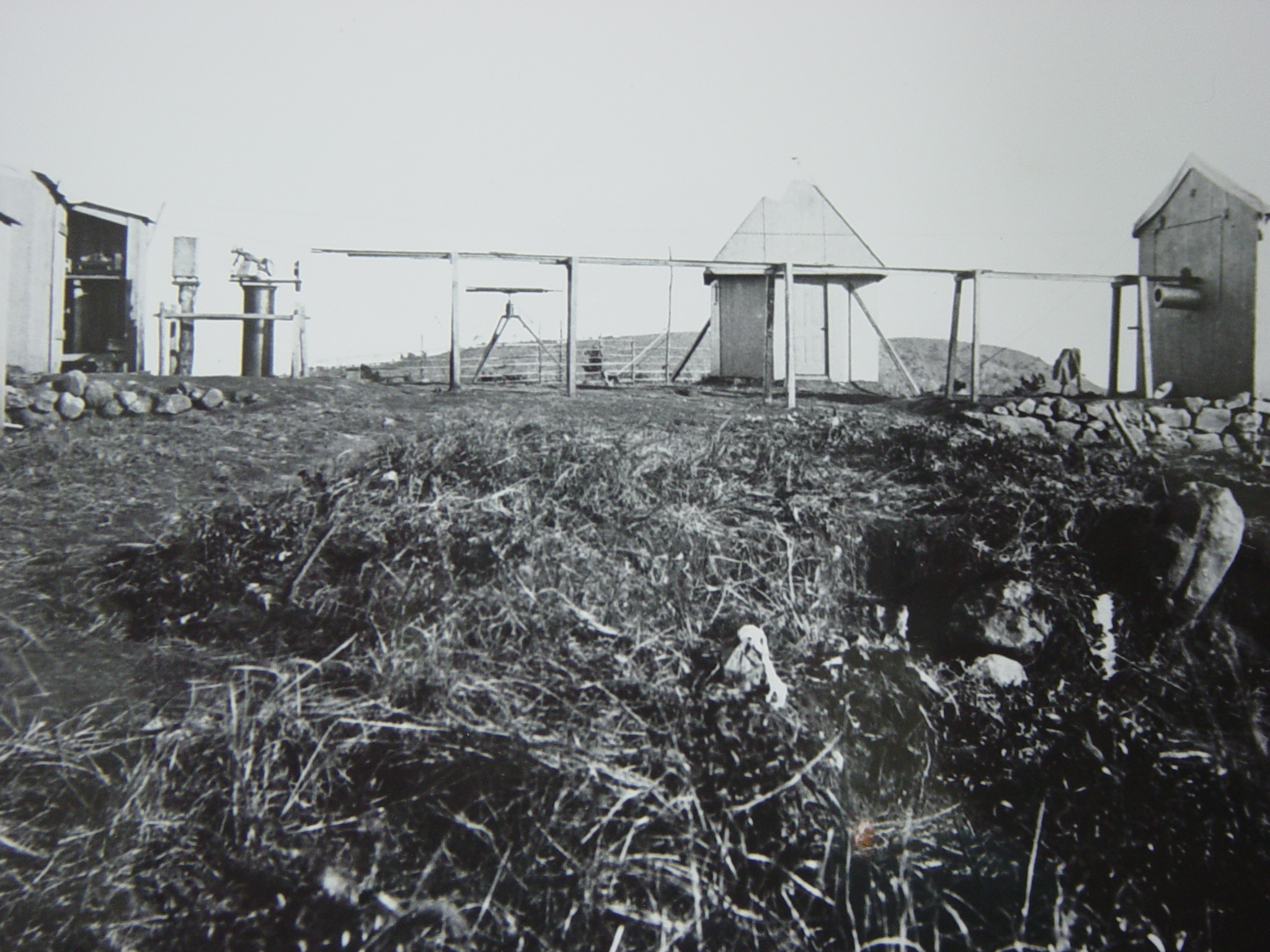
Figure 3: The setup of the U. S. Nagasaki station in 1874 with a photoheliograph (no photographs of the 1882 observing stations are available at U. S. N. O.): On the left side, a pillar carries the heliostat; the solar rays are deflected by a mirror and pass through a lens and a small tube into a hut (at right) where the photographic plates are exposed (U. S. Naval Observatory photograph; courtesy of Chuck Bueter).
The expedition arrived on October 30 in Valparaiso after a four-week-long trip, and arrived in Santiago the next day. The general Marcos Maturana offered them a spacious backyard ("un solar") belonging to the cartridge factory ("Fabrica de Cartouchos") which was situated to the south of the Parque Bernardo O'Higgins. The head of the U. S. group was Lewis Boss (Dudley Observatory, Albany), who was accompanied by a second astronomer, Miles Rock (US Naval Observatory), and two photographers, Theodore C. Marceau and Charles S. Cudlip.
On November 21, the photoheliograph was set up, and on the day of the transit, 240 collodium plates were taken (Fig. 4). Owners of digital cameras who are curious how to do such a job may consult Zegers' report; recipes how to prepare the emulsion, how to develop, and how to fixate are given there: take 1 ounce egg-white, 15 ounces water and 15 drops of concentrated ammonium...
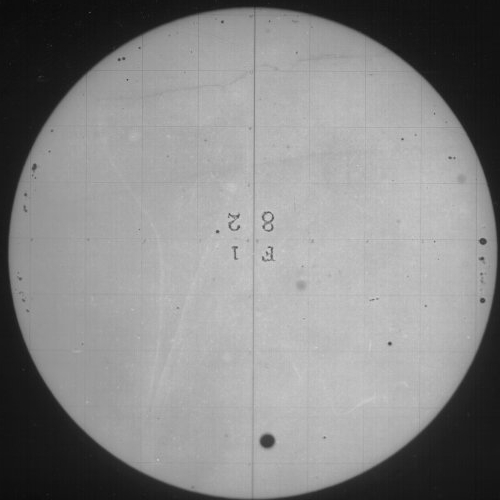
Figure 4: One of the few surviving solar photographs of the U. S. expeditions; north is at the top. It is unknown at what station this plate was taken (U. S. Naval Observatory photograph).
The director of the U. S. Naval Observatory, Simon Newcomb, while having initiated the U. S. Venus transit project, by 1882 had reached a very critical opinion about its scientific value, and preferred other methods to determine the solar parallax. Thus it fell to his colleague, William Harkness, to organize the expeditions and to analyze the observations. In 1889, he presented a more or less final result, 8.842±0.0118 arc seconds, based on 1475 plates of the 1882 transit (Harkness 1891). Although it had been planned to publish the details of the observations, this was never done due to lack of funds - of the projected 4-volume report of the 1874 U. S. observations, one volume was published, and the single copy of the proofs of a second volume can now be downloaded from ADS.
The Brazilian Group
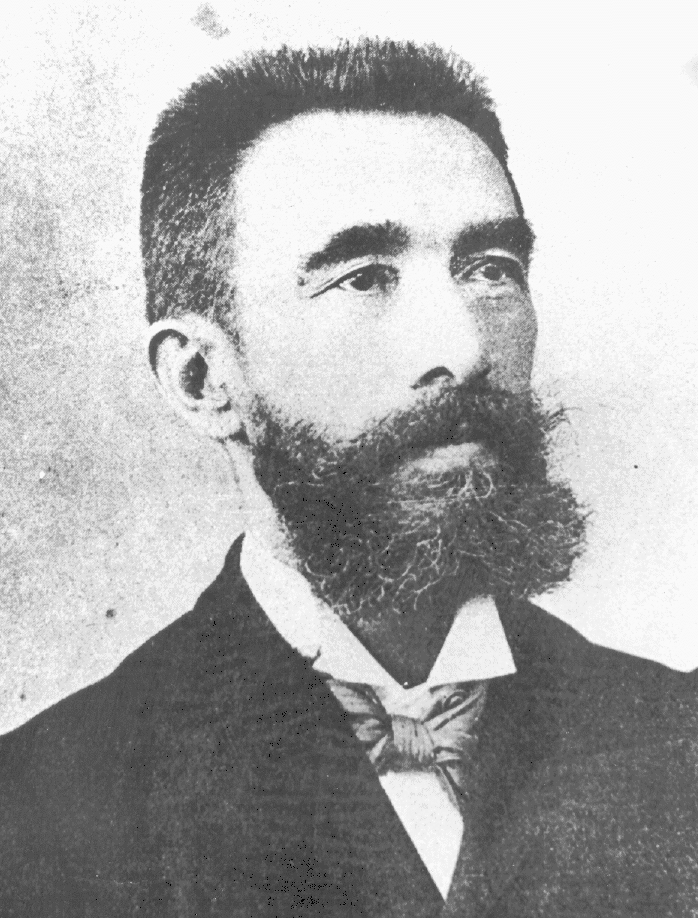
Figure 5: Luis Cruls, head of the Brazilian expedition to Punta Arenas (Observatorio Nacional, Rio de Janeiro).
Three Brazilian groups observed the transit: one on the island of San Thomas (Antilles), another one in Pernambuco (Olinda/Brazil) and a third one in Punta Arenas, Chile. The Punta Arenas party consisted of the director of Rio de Janeiro Observatory, Belgian-born Luis Cruls (Fig. 5), and his mechanic, Moreira de Assis.
The Brazilian party was brought to Punta Arenas (Fig. 6) by the frigate Parnahyba of the Brazilian Navy, under the command of captain Luiz Philippe de Saldanha da Gama, who wrote extensive "travel notes" for the astronomical report. He later became admiral and director of the naval school, took part in a revolt, and died in 1895 during a federalist revolution in Brazil. Saldanha da Gama's quite refreshing notes describe the trip from Rio via Montevideo (where ships of French and U. S. expeditions were met) to Punta Arenas. On the day of the transit, the Parnahyba was sent off to "Quartermaster Island" to carry out independent observations, which could only be done imperfectly due to poor weather. When Saldanha da Gama and his crew returned the night after the transit, they found Cruls asleep and woke him up. The report reads:
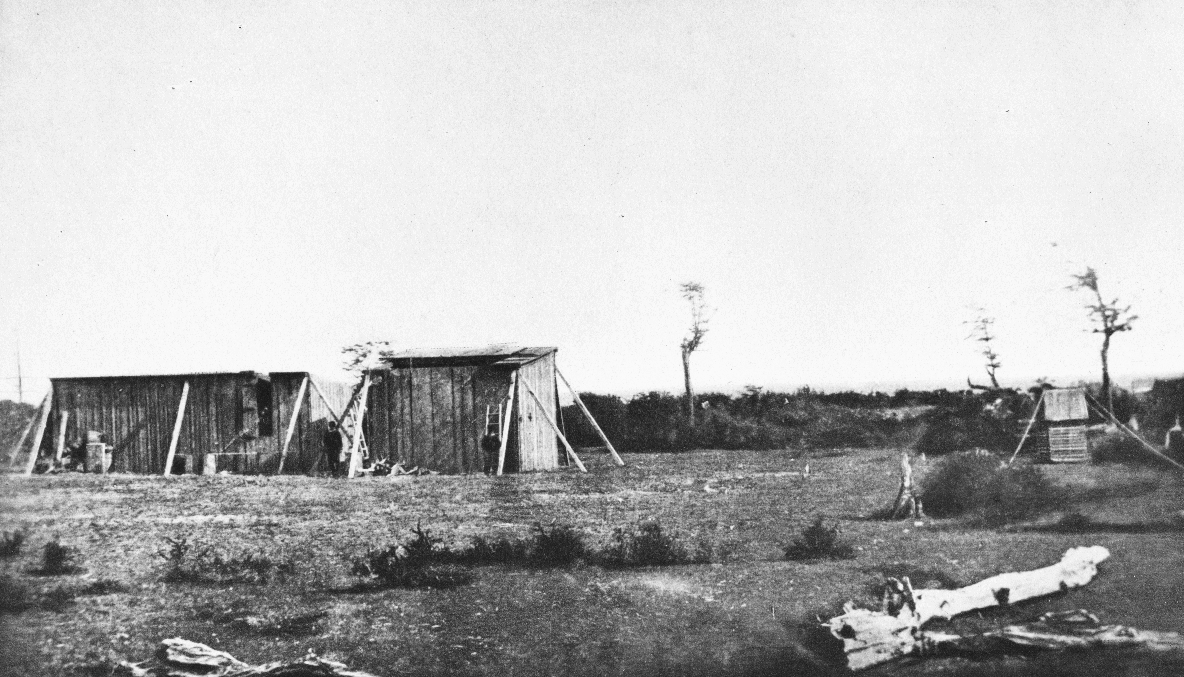
Figure 6: The observing huts of the Brazilian expedition (from Annales de l'Observatoire impérial de Rio de Janeiro, tome 3, 1887).
Two short words, rapidly spoken, were exchanged, they said everything. - "Então?" (How was it?) asked the commander anxiously. - "Completo" (Achieved) replied the astronomer and smiled. And then both men shook hands, quietly and with emotion."
While the Brazilian Groups only used the timings of second and third contacts (second only from Punta Arenas, third from all three stations), their final discussion (Cruls 1887), which just runs over five pages of the Annals, and is based only on a handful of measurements, yields a result, remarkably close to the modern value, but in my opinion a very uncertain one: 8.808 arc seconds (no error given).
The German Group
A German commission had set up a very detailed scheme of observing the Venus transits of 1874 and 1882 by means of heliometers and photoheliographs. Because the latter had turned out to yield very inaccurate results, the 1882 expeditions to Hartford (Connecticut), Aiken (South Carolina), Bahia Blanca (Argentina) and Punta Arenas (Chile) concentrated only on visual, and almost exclusively on heliometer observations.
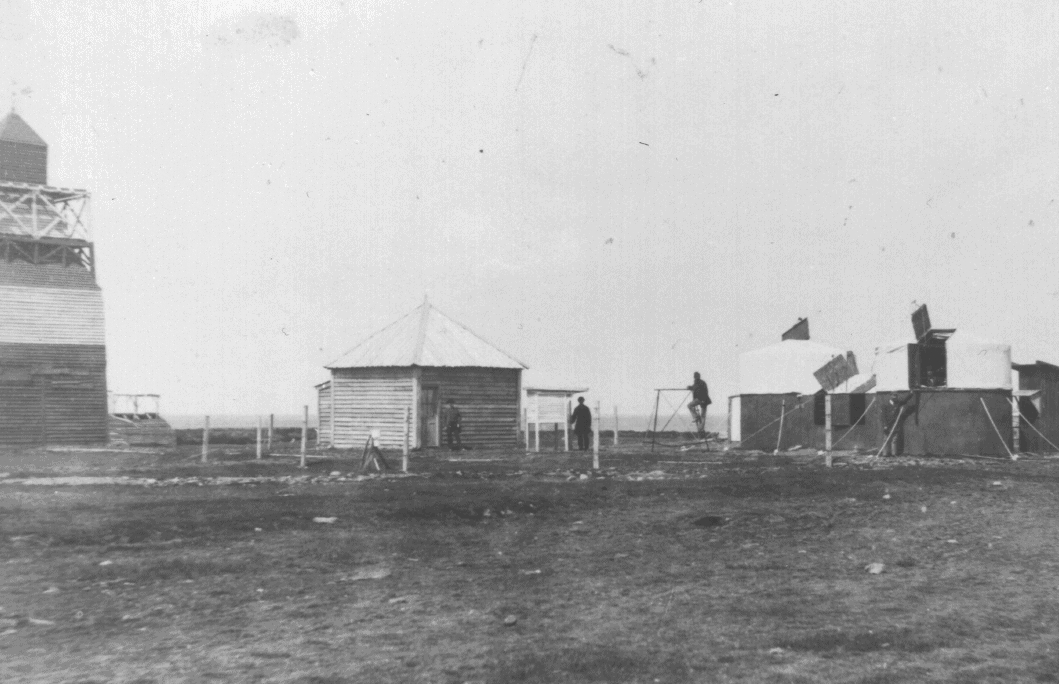
Figure 7: Photograph of the German station in Punta Arenas. Left, wooden lighthouse of Punta Arenas, center, "tea house" and meteorological station, right, two observing domes made from iron and canvas (Archiv, Berlin-Brandenburgische Akademie der Wissenschaften).
The expedition to Punta Arenas (Fig. 7) was led by Friedrich Küstner (who established the reality of the Earth's polar motion). He was accompanied by astronomer Paul Kempf (a pioneer of stellar photometry), geologist Gustav Steinmann, and mechanic Friedrich Schwab, who was also an amateur astronomer. On short notice, the head of the German Venus transit commission, Arthur Auwers, astronomer at the Berlin Academy of Sciences, accompanied by his servant, joined the party (Fig. 8).
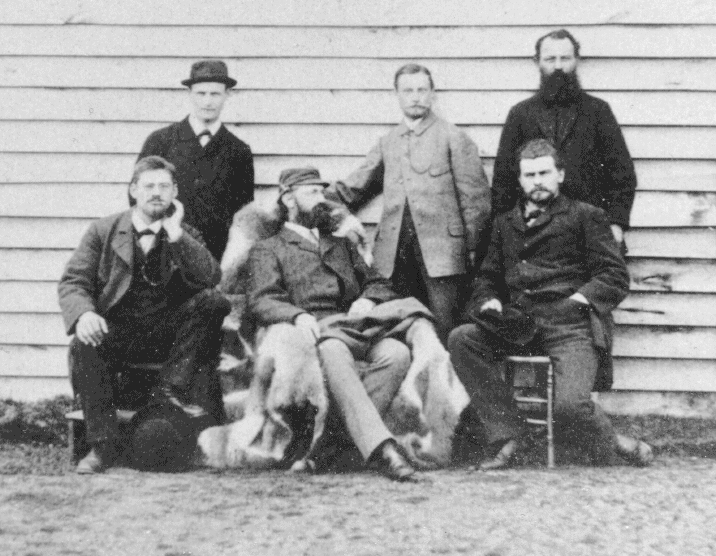
Figure 8: The German party in front of the "tea house". From left to right, first row: Gustav Steinmann, geologist; Arthur Auwers, head of the transit project; Friedrich Küstner, astronomer; second row: Friedrich Schwab, mechanic, Paul Kempf, astronomer, Bohne, servant (Archiv, Berlin-Brandenburgische Akademie der Wissenschaften).
Let us quote some notes from Auwers' official diary to learn some details of the expedition to Chile (the notes have been abridged): "1882 August 29. Dr. Küstner received the written instructions for the expedition and its cash-box, containing Mark 1200 and £100 in cash and a credit letter for Montevideo on another £100, and travelled from Berlin to Hamburg in the evening [Küstner and Steinmann used the steamer Rio to travel to Montevideo where they would join the others]. On September 5, 117 boxes were stored in the steamer Ramses of the Kosmos company. The ship left Hamburg on September 10 with the participants Kempf, Schwab and Bohne, while Auwers joined the group during a stop in Antwerp. The Ramses, a steamer of 1166 tons, and a crew of 38, left Antwerp on 1882 September 14."
In the morning of October 11, the Ramses anchored on the roads of Montevideo, and the passengers met their companions who had travelled with the Rio. In the afternoon, the Ramses continued her trip to Punta Arenas, where she arrived on October 17. The trade house Schröder & Co took care of the passengers; but the journal says "because we arrived three days early, nothing had been prepared, and we had to stay on board during the first night. Then we were located in unfinished rooms, surrounded by workers. In the evening of October 18, a party with the Gobernator took place, and in the next morning, foundations of the observing towers were prepared. First observations, hampered by poor weather, began on October 29.
1882 October 31 - The collimator house is being erected. At 11 1/2 a.m. the "nobilities" of the town are invited to tour the almost finished observatory; this was followed by an official breakfast, which lasted till 6 p.m.
In the middle of November, the governor gave us a small wooden house, built by Chilean soldiers between the observatory and the lighthouse, which comprised a comfortable living room and a kitchen. This house very much facilitated the nightwatch on location and offered the possibility to carry out paperwork near the instruments."
Here are some quotations from Auwers' notes of the transit observations: "After multiple rain showers in the evening of December 5 and in the overcast night of December 5/6, the sky was clear on early December 6, and the air was very transparent...When the time of the transit came, the sky was partly covered with numerous large cumulus clouds. I used a 6-foot refractor. Before the first contact, I tried to find Venus outside the solar disk; the moving clouds were very disturbing. Shortly before the calculated first contact, the clouds left the sun, and the region remained clear for more than 5 minutes, and the image quality became very good. The first [outer] contact of the planet with the solar limb was seen at 21 hours, 8 minutes, 31 seconds of the chronometer [showing Greenwich time]...From 21 h 26 m I left the telescope exposed in order to observe the inner contact, at 21 h 27 m 4 s I guessed that the border of Venus' black disk touched the solar limb, while the [bright] circle belonging to the planet [caused by Venus' extended atmosphere] was still outside the sun; in the same moment the sun was completely obscured by a cloud" (Auwers 1898).
At 1 h 51 m local time, a thick cloud covered the sun for more than half an hour; the observers noticed that it was raining in the mountains, and almost gave up their expectations for further observations; but the sun reappeared and only thin cirrus remained in the sky. Auwers could observe the third and fourth contacts, although the seeing was not optimal. After Venus had left the solar disk, both Schwab and Auwers believed to be able to see Venus: "It was a round spot of somewhat stronger brightness than the sky background, with a bluish shine, without a well-defined limb, having a somewhat larger diameter than the planet in front of the sun."
After Christmas, when more observations to accurately determine the time and the geographical location had been made, the telescopes were disassembled and packed. On the last day of 1882, the meteorological station was closed, and on 1883 Januar 3, the Theben arrived to pick up Auwers, his servant and the mechanic. Steinmann and Küstner were officially released to carry out other projects in Chile, Kempf in Montevideo. On 1883 February 21, Auwers returned home to Berlin - after a trip of 4 months.
Auwers was also the one who, after his return, sat down and completed his 6-volume report on the expeditions (Auwers 1898). A lot of performance tests of the employed heliometers at different temperatures had to be carried out and reduced, and is documented on many hundreds of pages. His best result, based on the heliometer observations, was 8.8796±0.0373; it is an irony of fate that in 1898, around the time when Auwers finished writing his work in his Berlin office, two astronomers at Berlin's popular Urania Observatory, Gustav Witt and Felix Linke, discovered the minor planet Eros that would revolutionize the determination of the astronomical unit. Two years later, in 1900, an opposition was observed, and again, a very favorable one, in 1930. The first one led to a solar parallax of 8.7966±0.0047 (Hinks 1904), a very good result when compared with the present-day value of 8.794 148 are seconds.
A Summary
The previous transit of Venus took place when many smaller and younger nations became interested in astronomical research, and arranged for expeditions to observe the event. But time was not yet ripe to establish international cooperation in instrumentation and data reduction, as the 1882 international Venus conference indicated. The first major international astronomical project, the Carte du Ciel, launched in 1887, became a tiresome and eventually doomed enterprise. International cooperation in space science, nuclear physics, etc., is in present times an obvious choice, if not a necessity. In the 1950s European countries agreed to establish ESO, and almost all astronomical projects in Chile are nowadays multi-national enterprises, culminating in the construction of ALMA. William Harkness would be surprised how much astronomical matters have changed since the (half)-shadow of Venus previously fell on earth...
Acknowledgments
Many colleagues have supported my research on Venus transit expeditions; here I want to express my particular gratitude to Dr. Chris Sterken (Vrije Universiteit Brussel), to Dr. Wolfgang Knobloch and his staff (Berlin-Brandenburg Academy of Sciences Archive), as well as to the librarians of the Staatsbibliothek zu Berlin, the Observatorio Nacional, Rio de Janeiro, the European Southern Observatory, Santiago, the Royal Observatory of Belgium, Ukkel, and the U. S. Naval Observatory, Washington, D. C.
References
- Académie des Sciences 1883, Passage de Vénus du 6 Décembre 1882, Rapports préliminaires, Paris: Gauthier-Villars
- Anonymous 1882, La conférence internationale du passage de Vénus, La Revue Scientifique de la France et de l'Etranger, 3e sér., tome 3, 42
- Auwers, A. 1898, Die Venusdurchgänge 1874 und 1882. Bericht über die deutschen Beobachtungen, Erster Band, Berlin [Reichsdruckerei]
- Bouquet de la Grye, A. 1905, Le passage de Vénus sur le Soleil en 1882, Memoires de l'Académie des Sciences de l'Institut de France, tome 48, 1
- Cruls, L. 1887, Discussão final e calculo da parallaxe/Discussion finale et calcul de la parallaxe, Annales de l'Observatoire impérial de Rio de Janeiro, t. 3, Rio de Janeiro: H. Lombaerts, [separate page numbering] 115
- Dick, S. J. 2003, Sky and Ocean Joined. The U. S. Naval Observatory 1830 - 2000, Cambridge: Cambridge University Press (esp. Chapter 7)
- Encke, J. F. 1824, Der Venusdurchgang von 1769 als Fortsetzung der Abhandlung über die Entfernung der Sonne von der Erde, Gotha: Becker
- Fernie, D. 2002, Setting Sail for the Universe. Astronomers and Their Discoveries, Rutgers University Press, New Brunswick; chapters 19 - 23
- Halley, E. 1716, Methodus singularis..., Philosophical Transactions 29, 454
- Harkness, W. 1882, On the Transits of Venus, Nature 27, 114 (Nov. 30, 1882)
- Harkness, W. 1891, Solar Parallax from the Transit of Venus Photographs of 1882, PASP 3, 46
- Hinks, A. R. 1904, Reduction of 295 Photographs of Eros made at Nine Observatories during the period 1900 November 7 - 15, with a determination of the Solar Parallax, MNRAS 64, 701
- Houzeau, J. C. 1884, Passage de Vénus du 6 Décembre 1882, Annales de l'Observatoire Royal de Bruxelles, N. S., Tome V., premier fasc.
- Janiczek, P. M. 1983, Remarks on the Transit of Venus Expedition of 1874, in Sky with Ocean Joined, Proceedings, edited by S. J. Dick and L. E. Doggett, U. S. Naval Observatory, Washington, D. C., p. 53
- Newcomb, S. 1890, Discussion of Observations of the Transits of Venus in 1761 and 1769, Astronomical Papers prepared for the use of the Americal Ephemeris and Nautical Almanac, Vol. 2, Washington: U. S. Government Printing Office, part V, 259
- Niesten, L. 1883, Mission du Chili, Annuaire de l'Observatoire Royal de Bruxelles, 51me année (1884), 123
- Saldanha da Gama, L. F. de 1887, Notas de Viagem/Notes de Voyage, in Annales de l/Observatoire impérial de Rio de Janeiro, t. 3, Rio de Janeiro: H. Lombaerts, [separate page numbering] 114
- Woolf, H. 1959, The Transits of Venus. A Study of Eighteenth-Century Science, Princeton: Princeton University Press
- Zegers, L. L., 1883, Transito de Venus por el Sol. Noticia historica de las observaciones practicadas en Santiago de Chile, Santiago de Chile: Imprenta de "El Progreso"
- Zegers, L. L., Salazar, A. E. 1896, Esperimentos sobre la produkzion de los rrayos de Röntgen por medio de las lamparillas de kadenzia eléctricas, Actes de la Société Scientifique du Chili, t. 6, p. 21
Go to the corresponding Brief InfoSheet
Back to the List of Extended InfoSheets.
Notes
[1] Wriiten by Hilmar W. Duerbeck, WE/OBSS, Vrije Universiteit Brussel, Belgium (hduerbec@vub.ac.be)